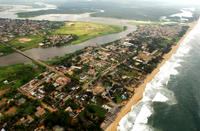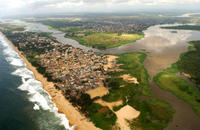You are in: Africa -> Côte d'Ivoire -> Historic Town of Gra... , and traditional search or Image Gallery will yield results of this site only
Historic Town of Grand-Bassam
| Site number: | 1322 |
|
| Type of site: | Cultural | |
| Date: | 1850 - 1950 | |
| Date of Inscription: | 2012 | |
| Location: | Africa, Côte d'Ivoire, Grand-Bassam | |
Up to 75 images are shown here. Click on each for more details or on Image Gallery for more images.
| Description: | The first capital of Côte d’Ivoire, the Historic Town of Grand-Bassam, is an example of a late 19th- and early 20th-century colonial town planned with quarters specializing in commerce, administration, housing for Europeans and for Africans. The site includes the N’zima African fishing village alongside colonial architecture marked by functional houses with galleries, verandas and gardens. Grand-Bassam was the most important port, economic and judicial centre of Côte d’Ivoire. It bears witness to the complex social relations between Europeans and Africans, and to the subsequent independence movement. As a vibrant centre of the territory of French trading posts in the Gulf of Guinea, which preceded modern Côte d’Ivoire, it attracted populations from all parts of Africa, Europe and the Mediterranean Levant. --WHMNet's description is from WHC Site, where additional information is available. | |
| Grand-Bassam is a city in Côte d'Ivoire, lying east of Abidjan. It was the French colonial capital city from 1893 until 1896, when the administration was transferred to Bingerville after a bout of yellow fever. The city remained a key seaport until the growth of Abidjan from the 1930s. Grand-Bassam is the chief city of Grand-Bassam Department. The city has the aura of a ghost town, since large sections have been abandoned for decades. In 1896 the French capital was moved to Bingerville, and commercial shipping gradually declined until it virtually ceased in the 1930s. In 1960, with independence, all remaining administrative offices were transferred to Abidjan, and for many years Grand Bassam was inhabited only by squatters. Beginning in the late 70s the city began to revive as a tourist destination and craft center. It now has a year-round population of approximately 5000. The city is divided by the Ébrié Lagoon into two halves: Ancien Bassam is the former French settlement, facing the Gulf of Guinea. It is home to the grander colonial buildings, some of which have been restored. The district is also home to a cathedral and the Côte d'Ivoire National Museum of Costume. Nouveau Bassam, linked to Ancien Bassam by a bridge, lies on the inland, northern side of the lagoon. It grew from the African servant's quarter and is now the main commercial centre of the town. The city is the seat of the Roman Catholic Diocese of Grand-Bassam. The Diocese's cathedral is the Cathédrale Sacré Cœur in Grand-Bassam. --Wikipedia. Text is available under the Creative Commons Attribution-ShareAlike License. | ||
| Source: | http://whc.unesco.org/en/list/1322 | |
| Reference: | 1. UNESCO World Heritage Center (http://whc.unesco.org/en/list/1322). 2. Wikipedia. | |









